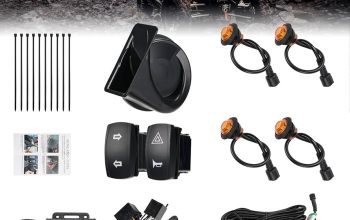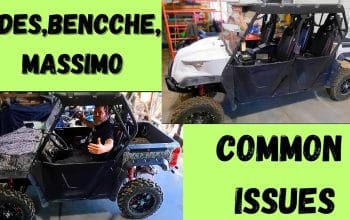Yamaha Rhino 700 owners often report issues with the engine, electrical system, and transmission. These Yamaha Rhino 700 Problems can affect performance and reliability. In this article we will discus the causes and solutions of those issues. I
The Yamaha Rhino 700 is a popular side-by-side utility vehicle known for its versatility and rugged design. Despite its popularity, owners have reported various issues that can impact the vehicle’s performance. Common problems include engine overheating, electrical malfunctions, and transmission failures.
These issues can be frustrating for users who rely on the Rhino 700 for both recreational and work-related activities. Regular maintenance and timely repairs are essential to ensure the vehicle operates smoothly. Understanding these common problems can help owners address them promptly and maintain the longevity of their Yamaha Rhino 700.
Engine Performance Issues
The Yamaha Rhino 700 is a reliable vehicle. But, it can have engine performance issues. These problems can affect your ride. Here, we discuss two main issues: starting problems and power loss.
Starting Problems
Many riders face starting problems with the Yamaha Rhino 700. This can be frustrating. Here are some common causes:
- Weak Battery: A weak battery can cause starting issues.
- Faulty Starter: The starter motor may fail over time.
- Dirty Spark Plug: A dirty spark plug can hinder ignition.
To fix these issues:
- Check the battery voltage. Replace if needed.
- Inspect the starter motor. Repair or replace if faulty.
- Clean or replace the spark plug.
Power Loss
Power loss is another common issue. This can make your Rhino feel sluggish. Here are some causes:
- Clogged Air Filter: A clogged air filter restricts airflow.
- Fuel Issues: Bad fuel can cause poor engine performance.
- Exhaust Problems: A clogged exhaust can reduce power.
To address power loss:
- Check and clean the air filter regularly.
- Ensure you use fresh, high-quality fuel.
- Inspect the exhaust system for clogs. Clean if necessary.
Transmission Troubles
The Yamaha Rhino 700 is a powerful utility vehicle. Yet, it faces transmission troubles. These issues can affect performance. Let’s explore the key problems.
Shifting Difficulties
One common issue is shifting difficulties. Owners report problems with gear shifting. This can be frustrating during rides. Potential causes include:
- Worn-out gear teeth
- Inadequate lubrication
- Misaligned shift linkage
Regular maintenance can help. Check the shift linkage often. Lubricate the gears properly. This can reduce shifting problems.
Clutch Wear
Clutch wear is another frequent problem. The clutch is vital for smooth operation. Over time, it can wear out. Signs of clutch wear include:
- Slipping clutch
- Strange noises
- Difficulty in engaging gears
To prevent clutch wear, inspect it regularly. Replace worn-out parts promptly. Use quality parts for replacements. This ensures longer clutch life and better performance.
Suspension Concerns
The Yamaha Rhino 700 is a powerful UTV, but it has suspension issues. These concerns can affect the ride quality and safety. Understanding these problems helps in maintaining your vehicle better.
Shock Absorber Failures
Shock absorbers in the Yamaha Rhino 700 often fail. These failures can make the ride bumpy. Worn-out shocks may cause the vehicle to bounce excessively.
- Frequent bouncing
- Uneven tire wear
- Reduced control
Owners have reported shocks leaking oil. Leaking shocks lose their effectiveness. This reduces the suspension system’s ability to absorb impacts.
Replacing shocks is sometimes necessary. Use high-quality replacements for better performance. Routine inspection of shocks can help prevent sudden failures.
Handling Instability
Handling instability is another concern with the Yamaha Rhino 700. This problem often occurs due to imbalanced suspension. Poor handling makes the vehicle difficult to control.
Common signs of handling instability include:
- Vehicle pulling to one side
- Difficulty steering
- Increased body roll
Improper wheel alignment can cause handling issues. Regular alignment checks can help maintain stability. Suspension components should be inspected for wear and tear.
Maintaining proper tire pressure is crucial. Both over-inflated and under-inflated tires can affect handling. Always check tire pressure before rides.
Electrical System Failures
The Yamaha Rhino 700 is a popular side-by-side vehicle. Despite its robust design, it can have electrical problems. Electrical system failures can be frustrating and disrupt your adventures. Below, we discuss some common issues.
Battery Drain
Battery drain is a frequent problem for many users. A weak battery can leave you stranded. Here are some reasons for battery drain:
- Old or faulty battery
- Leaving lights on
- Accessories draining power
Regular battery checks can prevent sudden failures. Charge the battery often. Ensure all electrical accessories are off when not in use.
Faulty Wiring
Faulty wiring is another common issue. It can cause various electrical failures. Look out for these signs:
- Lights flickering
- Intermittent starting problems
- Burnt smell
Inspect wiring regularly for wear or damage. Replace damaged wires immediately. Use a multimeter to check for continuity.
By addressing these electrical issues, you can extend your Yamaha Rhino 700’s lifespan.
Brake System Problems
The Yamaha Rhino 700 is a robust vehicle, but it has some issues. The brake system is one area where users report problems. Understanding these issues can help you maintain your Rhino 700 better.
Brake Fade
Brake fade is a common issue with the Yamaha Rhino 700. This happens when the brakes overheat. Overheated brakes lose their effectiveness. You might notice the vehicle doesn’t stop as quickly.
Several factors can cause brake fade:
- Frequent heavy braking
- Long downhill rides
- Poor brake fluid maintenance
To avoid brake fade, consider these tips:
- Use engine braking on long descents.
- Check and replace brake fluid regularly.
- Install high-temperature brake pads.
Squeaky Brakes
Squeaky brakes are another issue with the Rhino 700. This can be annoying and may indicate a problem. The squeak often happens because of dirty or worn brake pads.
Here are some common causes of squeaky brakes:
- Dust and dirt on the brake pads
- Worn-out brake pads
- Lack of lubrication on brake parts
To fix squeaky brakes, follow these steps:
- Clean the brake pads and rotors.
- Replace worn-out brake pads.
- Apply brake lubricant to key parts.
Steering Issues
The Yamaha Rhino 700 is a popular off-road vehicle. But it has some common steering issues. Knowing these problems helps you maintain your Rhino better.
Steering Play
Steering play can make your ride unsafe. This means there’s a gap or looseness in the steering wheel. You might notice the wheel moves without turning the tires.
Common causes of steering play include:
- Worn-out tie rods
- Loose steering rack
- Damaged bushings
Inspect these parts regularly. Replace any worn or damaged components.
Alignment Problems
Alignment problems affect the vehicle’s handling and tire wear. You might feel the Rhino pulling to one side.
Signs of alignment issues:
- Uneven tire wear
- Steering wheel off-center
- Vehicle drifts to one side
To fix alignment problems, check the suspension components. Adjust the tire angles to the manufacturer’s specifications. Regular alignment checks can prevent these issues.
| Problem | Signs | Solutions |
|---|---|---|
| Steering Play | Loose steering wheel | Inspect and replace tie rods, steering rack, bushings |
| Alignment Problems | Uneven tire wear, drifting | Check suspension, adjust tire angles |
Cooling System Failures
The Yamaha Rhino 700 is a popular ATV, but it has issues. One major problem is cooling system failures. These failures can lead to serious damage. Let’s explore the common problems.
Overheating
Overheating is a common issue with the Yamaha Rhino 700. It can cause the engine to shut down. This happens mostly during long rides. The engine gets too hot and stops working.
Here are some signs of overheating:
- High engine temperature
- Steam from the radiator
- Loss of power
Radiator Leaks
Radiator leaks can also cause cooling issues. Leaks happen due to damaged hoses or a cracked radiator. This leads to coolant loss and overheating.
Signs of a radiator leak:
- Coolant on the ground
- Low coolant levels
- Visible cracks or holes in the radiator
Preventing these issues is important. Regular maintenance can help. Check the radiator and hoses often. Refill coolant as needed. Keep your Yamaha Rhino 700 running smoothly.
Fuel System Troubles
The Yamaha Rhino 700 is a powerful machine, but it is not without issues. One common area of concern is the fuel system. Problems in this area can lead to poor performance and frustration. This section will cover two major fuel system troubles: Fuel Pump Failures and Fuel Injector Issues.
Fuel Pump Failures
Fuel pump failures are a frequent issue in the Yamaha Rhino 700. The pump can stop working, leading to engine stalling. This problem can be caused by:
- Clogged fuel filters
- Electrical issues
- Wear and tear
Regular maintenance can help prevent these problems. Always check the fuel filter and replace it if needed. Inspect the wiring for any signs of damage.
Fuel Injector Issues
Fuel injector problems can also plague the Yamaha Rhino 700. Dirty or faulty injectors can cause:
- Engine misfires
- Rough idling
- Poor fuel economy
Cleaning the injectors can sometimes fix these issues. If cleaning does not help, consider replacing the injectors. Always use high-quality fuel to keep the injectors clean.
| Problem | Possible Cause | Solution |
|---|---|---|
| Fuel Pump Failures | Clogged Filters, Electrical Issues | Check and Replace Filters, Inspect Wiring |
| Fuel Injector Issues | Dirty or Faulty Injectors | Clean or Replace Injectors |
Frequently Asked Questions
Why Was The Yamaha Rhino Discontinued?
Yamaha discontinued the Rhino due to safety concerns and legal issues. It faced numerous lawsuits over rollover accidents.
What Years Were The Yamaha Rhino 700 Made?
The Yamaha Rhino 700 was manufactured from 2008 to 2013. This popular side-by-side model gained a strong following.
How To Make A Yamaha Rhino 700 Faster?
Upgrade the exhaust system, install a high-flow air filter, and reprogram the ECU. Use lighter clutch weights for better acceleration.
What Is The Top Speed Of A Yamaha Rhino 700?
The top speed of a Yamaha Rhino 700 is approximately 42-45 mph. This speed can vary slightly based on conditions.
Conclusion
Owning a Yamaha Rhino 700 can present some challenges. Regular maintenance and understanding common issues can save time and money. Stay informed and proactive to enjoy a smoother ride. Addressing these problems early ensures your Rhino 700 remains reliable and fun for years to come.


